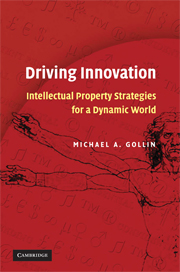Book contents
- Frontmatter
- Contents
- Foreword
- Preface
- Acknowledgments
- Abbreviations
- Introduction: The Invisible Infrastructure of Innovation
- PART I INTELLECTUAL PROPERTY DYNAMICS IN SOCIETY
- 1 Intellectual Property and the Innovation Cycle
- 2 The Rise of the Intellectual Property System
- 3 Keeping the System in Balance: Exclusion and Access
- PART II BASICS OF MANAGING INTELLECTUAL PROPERTY IN ORGANIZATIONS
- PART III STEPS TO STRATEGIC MANAGEMENT OF INTELLECTUAL PROPERTY
- PART IV STRATEGIES ON A GLOBAL STAGE
- APPENDIX A Excerpts from TRIPS Agreement
- APPENDIX B Intellectual Property Non-Policy
- APPENDIX C Intellectual Property Assessment Questionnaire
- APPENDIX D Research Tools for Obtaining Intellectual Property Information
- Bibliography
- Index
1 - Intellectual Property and the Innovation Cycle
Published online by Cambridge University Press: 05 June 2012
- Frontmatter
- Contents
- Foreword
- Preface
- Acknowledgments
- Abbreviations
- Introduction: The Invisible Infrastructure of Innovation
- PART I INTELLECTUAL PROPERTY DYNAMICS IN SOCIETY
- 1 Intellectual Property and the Innovation Cycle
- 2 The Rise of the Intellectual Property System
- 3 Keeping the System in Balance: Exclusion and Access
- PART II BASICS OF MANAGING INTELLECTUAL PROPERTY IN ORGANIZATIONS
- PART III STEPS TO STRATEGIC MANAGEMENT OF INTELLECTUAL PROPERTY
- PART IV STRATEGIES ON A GLOBAL STAGE
- APPENDIX A Excerpts from TRIPS Agreement
- APPENDIX B Intellectual Property Non-Policy
- APPENDIX C Intellectual Property Assessment Questionnaire
- APPENDIX D Research Tools for Obtaining Intellectual Property Information
- Bibliography
- Index
Summary
This first part of the book includes three chapters about intellectual property dynamics in society. Chapter 1 begins with a description of innovation as a force of creative destruction and then provides a brief history, asking the question of why people innovate. This chapter introduces the concept of the innovation cycle, with its three stages: individual creativity, social adoption, and access to knowledge. IP laws and practices affect each stage. First, IP laws provide incentives that strengthen the individual's will to create. Second, the exclusivity that defines intellectual property rights allows groups to share and invest in developing the creative works of individuals within their innovative communities, and to control the dissemination of those works more broadly in society. Third, the exclusivity of IP rights is limited, so that creative individuals and communities can access the innovations of others, and the innovation cycle can go forward. Intellectual property thus captures and channels and shapes innovation, ideally linking individual inspiration with collective labor and balancing the rights of creators against the rights of others. The chapter concludes by noting the dark side of innovation, and limits on the role of intellectual property.
INNOVATION AND CREATIVE DESTRUCTION
Innovation is a powerful force of human nature. Innovation creates new businesses, cultural movements, and social institutions, and destroys, replaces, or leaves behind the old ones. Innovation feeds on the known and converts it into the new.
- Type
- Chapter
- Information
- Driving InnovationIntellectual Property Strategies for a Dynamic World, pp. 11 - 21Publisher: Cambridge University PressPrint publication year: 2008



